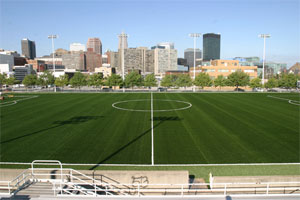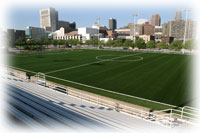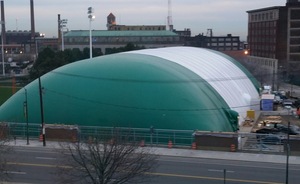The Wolstein Center -- Goodman Arena
The Bert L. and Iris S. Wolstein Center (formerly the CSU Convocation Center) was renamed in 2005 in honor of Bert L. Wolstein, a 1953 graduate of the Cleveland-Marshall College of Law and a 2003 recipient of Cleveland State's Distinguished Alumni Award. The Wolstein Center has become the one of the most exciting multi-purpose, college-owned facilities in the country.
On November 1, 1991, the ribbon was cut, officially opening the Wolstein Center. The beautiful $55,000,000 state-of-the-art, full-service, multi-purpose facility means many things to many facets of the Cleveland community.
To the Cleveland State athletics, it means fruition of a dream- - a home for CSU's basketball teams which had been envisioned almost since the day that a state university was born from the seeds of little Fenn College in downtown Cleveland.
The dream came true in 1991 in the form of the largest college-owned basketball arena in the State of Ohio with a seating capacity of 13,610.
Every seat in the basketball configuration is a theater-style cushioned chair, approximately 3,000 of which can be rolled back to create a larger playing surface for indoor soccer games, indoor track meets, and major wrestling tournaments.
In addition to CSU athletics, the Wolstein Center has hosted some of the hottest shows in rock, pop, and country including Bruce Springsteen, Prince, Sting, Usher, Elton John, Martina McBride, Brad Paisley, Christina Aguilera, and Alan Jackson. Family shows like the American Idols, High School Musical, Barney, The Wiggles, and Cirque du Soliel, have thrilled fans of all ages.
Four large corner scoreboards, two with full-color animation capabilities, are situated in the corners of the arena. The scoreboards also boast a computerized sound system considered to be one of the most advanced in the country. In addition, a computerized lighting system bathes the basketball court in 200 foot-candles of light. An auxiliary scoreboard graces the official scorer's table. Media tables situated across the floor are equipped with electrical outlets. There is media seating for working press members at the floor level.
Six locker rooms, including permanent pro style locker facilities for the CSU men's and women's basketball teams, ring the floor level, along with several smaller rooms for officials and performers. Adjoining rooms to the dressing areas are used for post-game interviews and as a working press room.
The arena has been named the Henry J. Goodman Arena in honor of the former chairman of the Cleveland State University's Board of Trustees, a moving force in the realization of the University's dream of a very special building for its students and the community it serves.
East of the main bowl stands the Gerald H. Gordon Conference Pavilion, named in honor of the chairman of the board of trustees Building Committee, another prime force in the planning and construction of the building.
Contained in the Pavilion is a large auxiliary gym which will serve as a practice facility for the varsity basketball teams and other designated athletic activities. Also located there are the offices of the men's and women's basketball staffs and of the Athletic Department's administrative staff.
Two large conference rooms that can accommodate approximately 600 persons and may be used for pre- and post-game functions are also located in the Pavilion. They are adjoined to the entertainment and assembly area, the Patrick Sweeney Atrium honoring the Ohio state senator whose yeoman efforts on behalf of the Wolstein Center's construction went far beyond the simple call of duty to his constituents.
Above the conference rooms in the luxurious Viking Loge, a large dining and entertainment center which includes a buffet area and three rows of alternating tables and chairs overlooking the arena. The room is used during basketball games for major donors to the athletic program, their guests and other special guests of the University.
The Wolstein Center is operated as a full-service facility with a full-time staff to manage and administer special events, a computerized ticketing service and marketing services for event planners.
Krenzler Field
Krenzler Field, the home of Viking soccer for two decades, recently underwent a $2.9 million renovation that has transformed it from just a soccer field to a year-round multi-use sports complex.
Krenzler Field will also be home to the men's lacrosse team which will begin competition in the spring of 2017.
The renovations consisted of two major improvements, each of which has dramatically improved the athletic physical plant for all CSU sports. The natural grass playing surface was removed in favor of a state-of-the-art FieldTurf artificial field.
The addition of a removable air-supported dome is placed over the field, creating an indoor practice facility for all sports for the winter months.
The addition of FieldTurf was made necessary when the women's soccer was added at CSU, increasing the usage of the field to the point where it would be impossible to maintain the natural grass surface.
FieldTurf, a revolutionary playing surface that combines the properties of natural grass with the durability of artificial turf, has been installed on almost 1,000 playing surfaces in 20 countries around the world. It is currently in use in over half of the National Football League stadiums and by almost 50 NCAA Division I institutions. It has been approved for play by FIFA, the world governing body for soccer, with some of the top professional teams around the world currently practicing and playing on it.
The removable dome, a product of Yeadon Domes, covers the entire length of Krenzler Field, approximately 94,000 square feet, with a 60-foot ceiling. It is made of a heavy duty vinyl coated flame resistant polyester architectural fabric.
 The Krenzler Dome is a welcome addition, especially since the Intramural Sports Center, the only other indoor practice facility on campus, was demolished in the winter of 2005 to make way for the new Student Recreation Center.
The Krenzler Dome is a welcome addition, especially since the Intramural Sports Center, the only other indoor practice facility on campus, was demolished in the winter of 2005 to make way for the new Student Recreation Center.
The dome will benefit more than just soccer.
The baseball and softball teams will be able to hold preseason practices in the facility each winter with the space being large enough to set up a regulation softball field.
The size of the field also makes it possible to set up an indoor driving range for the golf teams or batting cages and pitchers mounds for both baseball and softball.
The renovation of Krenzler is the first step in the construction of CSU's Varsity Village, a concentration of university athletic facilities interwoven with new residential living spaces between E. 19th and E. 24th streets along the northern edge of campus. Future plans call for the addition of an on-campus baseball field, the relocation of Viking Field, the home of CSU softball, and the reconfiguring of the Malaga Tennis Center.
Built at an original cost of $1.9 million, Krenzler Field became the first university outdoor athletic venue when it was dedicated on October 18, 1985.
Designed and built specifically for varsity soccer, the field is nestled at the northwest corner of the campus against a background of downtown skyscrapers. The complex includes permanent seating for 1,680 and an electric scoreboard and clock, plus a field building housing two 36-person team locker rooms, a referee locker room, a training room, a storage room and public restroom facilities. The lighting system provides 50 footcandles of illumination.
The facility is named in honor of Judge Alvin I. Krenzler, a long-time supporter of the university. Krenzler served on the CSU Board of Trustees from July 1967 until August 1970, leaving the board when he became judge of the Eighth District Court of Appeals. He retired as judge of the United States District Court, Northern District of Ohio in 1992.
It was Krenzler's generous contribution - which at the time was the largest single gift ever made to CSU athletics - that made completion of the facility possible.
There is limited handicapped parking available for CSU soccer games. Please contact Mike Lehto at 216-687-4813 for arrangements.
The Robert F. Busbey Natatorium
For over 30 years, Cleveland State's natatorium has earned its place among the elite swimming facilities in the United States and has enjoyed a rich history of championships and outstanding swimmers. A new chapter in that history was written in the fall of 1999 when the facility was officially dedicated as The Robert F. Busbey Natatorium after CSU's long-time swimming coach and athletic director, Bob Busbey. Despite all the prestige, however, the one part of the natatorium that has continued to stand out over the years is how advanced the pool's design is when compared to others around the country.
When it opened in 1973 as the CSU Natatorium, it was considered special simply because it was one of only two university indoor pools in the state of Ohio that was 50 meters in length. Since there were not many other pools like it in the country, it received immediate notice from the rest of the swimming community.
However, there were other aspects of the pool that made it unusual. The one feature that immediately stood out was the pool's large gutters, which made it extremely fast compared to those of other schools. In March of 1975, the NCAA decided to examine the theory itself when it scheduled the NCAA Division I and II Championships in Cleveland for the very first time. Over the course of consecutive weekends, the NCAA came to the conclusion that the Busbey Natatorium was one of a kind.
Following this historic meet, the NCAA gave in to the demands of swimmers and coaches alike and decided to return the championship meet to Cleveland State. When the 1977 Division I Championships were completed, there was no doubt left as to which pool was superior in the United States. The meet featured the shattering of sixteen NCAA records; a mark that still stands today. In fact, the 1977 finals were later termed as "The greatest swimmers in the fastest pool at the greatest meet in history" by none other than the NCAA itself.
Two years later, the meet returned to Cleveland, and, after a five year lapse, it was back again for a fourth time in 1984 to sellout crowds yet again. Since that time, the Busbey Natatorium has also served as host to other top-notch collegiate championships. The pool has been an eleven-time host site of the Eastern Intercollegiate Championships and hosted the Penn-Ohio Conference Championships a staggering 17 times.
The natatorium has been the site of championships of all shapes and sizes during its history, including four Midwestern Collegiate Conference championships and the 2003 Horizon League Championship under current CSU Aquatics Director and Men's Swimming Coach Wally Morton's tenure. What may stand out the most is the variety of the 16 national aquatic championships that have been held at Cleveland State. These events include United States international diving meets, AAU and YMCA national championships, the National Water Polo Championships, and even the World Swimming Games for the Deaf.
The natatorium has remained dear to the hearts of United States swimmers as it has been used by the 1976 United States Olympic Swimming and Diving Teams, the 1980 Olympic Diving Team and the 1984 Olympic Swim Team for their practices. The pool has even witnessed record breaking performances by United States gold medal winners Tom Jager, Matt Biondi, Greg Louganis and Pablo Morales. In addition, the October 22, 2002 issue of Sports Illustrated ranked the Busbey Natatorium the sixth fastest pool in America.
The structure of the Busbey Natatorium itself is even unique. The fact that an incredible 933,000 gallons of water are needed to fill the pool is unusual. The natatorium measures 50 meters in length (with nine eight-foot competitive lanes) by 25 yards wide (with 23 seven-foot competitive lanes) with racing lanes measuring 12 to 16-1/2 feet deep. Below the surface, the pool features underwater speakers and six underwater windows which provide the CSU staff with an excellent coaching tool.
Also, the pool utilizes an automatic touchpad timing system for up to ten lanes during meets. In terms of diving competitions, the natatorium includes two one-meter maxiflex boards, two three-meter maxiflex boards, and a diving tower with platforms at 5, 7-1/2, and 10 meters.
For the swimming spectator, the Busbey Natatorium has a seating capacity of 1,500 fans. To boost the number of potential viewers, the university has constructed permanent television broadcast and camera platforms which have been used by the ABC, CBS, NBC and ESPN networks during the pool's illustrious history.
The pool's uniqueness is not limited to simply the main pool itself. The south stands feature a 25-yard instructional pool which is also very useful as a warm up/cool down pool for competitions.
In ceremonies held on October 2, 1999, the CSU Natatorium was officially renamed The Robert F. Busbey Natatorium, in honor of long-time swimming coach and athletic director, Bob Busbey. Over a span of nearly a half-century, beginning with his enrollment at Fenn College in 1946, Busbey impacted the University's sports program as only a special few men have at any collegiate institution.
As a four-sport athlete (swimming, baseball, track and fencing), Busbey was Fenn's first All-American, gaining national prominence by winning that honor as a swimmer in both 1948 and 1949 and failing by the tiniest margin to qualify for the U.S. Olympic team in 1950. He went on to serve as head coach of his alma mater (named Cleveland State University in 1964) for 30 years. During his coaching tenure, he was named Assistant Coach for the 1964 United States Olympic Team, served as chairman of the NCAA Swimming Committee and was responsible for bringing an NCAA Division II and four NCAA Division I Swimming Championships to Cleveland State between 1975 and 1982 -- a virtually unprecedented feat.
For his accomplishments, Busbey was honored with the 1982 National Collegiate & Scholastic Swimming Trophy, one of the sport's highest awards.
In 1966, Busbey succeeded Homer E. Woodling as Cleveland State's Director of Athletics. Over a span of 24 years in that position, he developed a flourishing program of 18 intercollegiate sports for men and women and became a prime force in the planning and building of CSU's athletic facilities -- Krenzler Field (hailed as one of the best college soccer stadiums in the country when it opened in 1985); the CSU Convocation Center (considered one of the premier arenas in college athletics); and the Physical Education Building, housing Woodling Gymnasium and the world-class Natatorium.
Unanimously voted a charter member of the Cleveland State Athletic Hall of Fame when it opened in 1975, Busbey became Associate Vice President for Athletic Affairs in 1990 and continued to serve his alma mater until his retirement in 1994.
For all its special features and the amount of events it has hosted in its 29 years, The Robert F. Busbey Natatorium truly enjoys one of the most fascinating histories of any aquatic facility in the United States.
Robert F. Busbey Natatorium Dedicated Lanes
25-Yard Course
Lane 1 - Michael H. Davidson
Lane 2 - Dave Guinther
Lane 3 - Jim & Susan Smith
Lane 4 - Robert F. Busbey
Lane 5 - Chuch Kunsman
Lane 6 - James F. Hoffmaster
Lane 7 - Mike Slabe
Lane 8 - Lorry Wagner
Lane 9 - Thomas P. Meehan
Lane 10 - Mr. & Mrs. William Dorenkott
50-Meter Course
Lane 3 - John P. Wilson
Lane 4 - Sharon Knecht Beinker and Craig Beinker
Lane 5 - The Lamers Family
Lane 6 - Danferd C. Avis
Lane 7 - Mr. & Mrs. David Zavagno
Lane 8 - Dr. Walter B. Waetjen (President Emeritus)
Lane 9 - Dieter Kulicke
3-Meter Diving Board
Richard J. Karban
10-Meter Platform
Jeff Arnold
Special thanks for helping to update the CSU record board: Mr. and Mrs. Stevenson, Mr. and Mrs. Thomas, Mr. and Mrs. Huszai, Henry Zeija, Marco Markgraaff & Mauricio Barrios
Woodling Gymnasium
Volleyball, wrestling and fencing call the Homer E. Woodling Gymnasium home. The 3,000 seat facility is located in the Physical Education Center which was opened in 1973. The facility is more than just a gym though as elsewhere in the building there are an 80' x 40' wrestling room, a two-story gymnastics room, two weight rooms, dance studio, remedial exercise room, human performance laboratory, trainer's suite with whirlpool and sauna areas, ten varsity and visitor's locker rooms, and locker facilities for 3,400 men and 2,000 women.
The building also houses the Physical Education Departments classrooms and offices. In addition, numerous coaches' and administrator's offices are located in Woodling Gymnasium.
Viking Field

The softball Vikings play their home games
The facility has hosted Horizon League Championships in 2003 and 1995 and the 1997 NCAA Play-In series in which the Vikings took two-of-three games from Florida A&M to advance to the NCAA Tournament for the first time in school history. The field dimensions range from 210 feet to center field and 195 feet in left and right field. on Viking Field, adjacent to the Krenzler Field soccer facility and Malaga Tennis Center on Chester Avenue. The field, opened in 1988, has permanent seating for 500 spectators. A new pressbox was erected at Viking Field in 1996, courtesy of friends of the softball team who donated their time and services.
 Medical Mutual Tennis Pavilion
Medical Mutual Tennis Pavilion
 The MMTP was officially dedicated on April 21, 2016, with officials cutting a ceremonial tennis net.
The MMTP was officially dedicated on April 21, 2016, with officials cutting a ceremonial tennis net.
